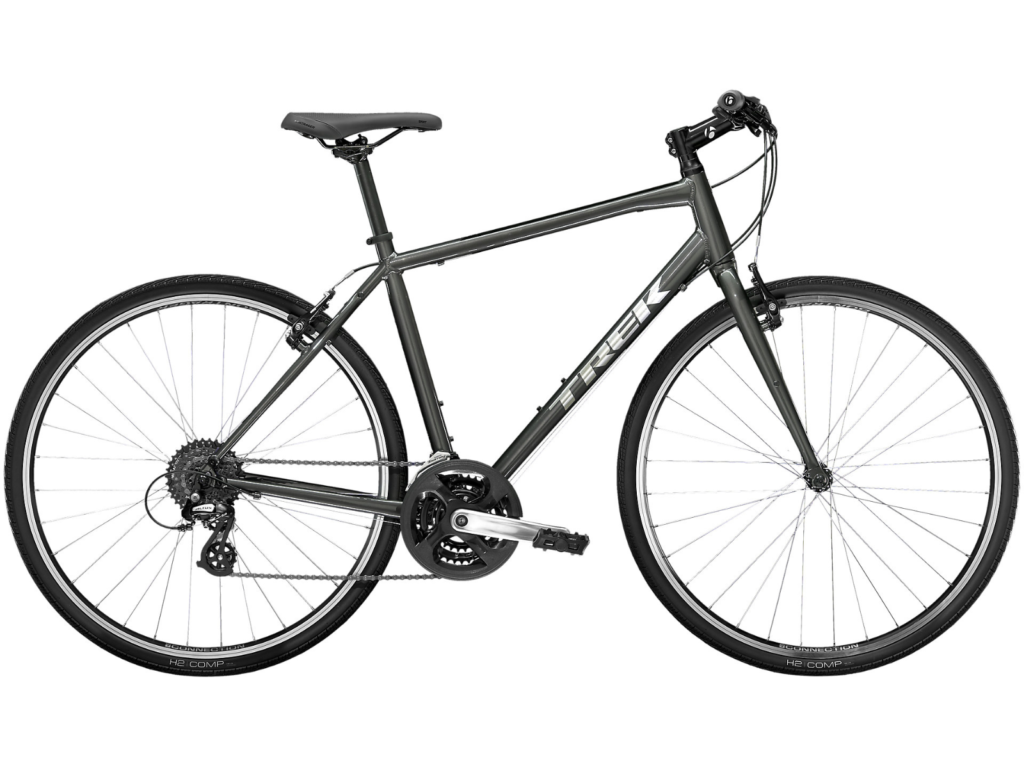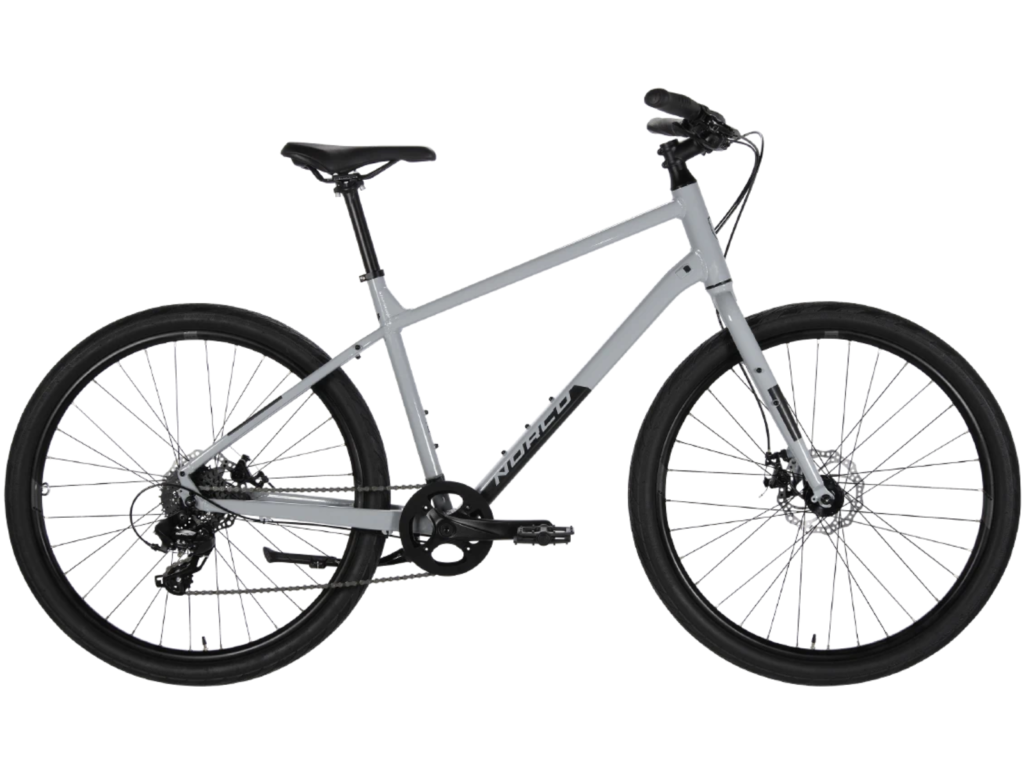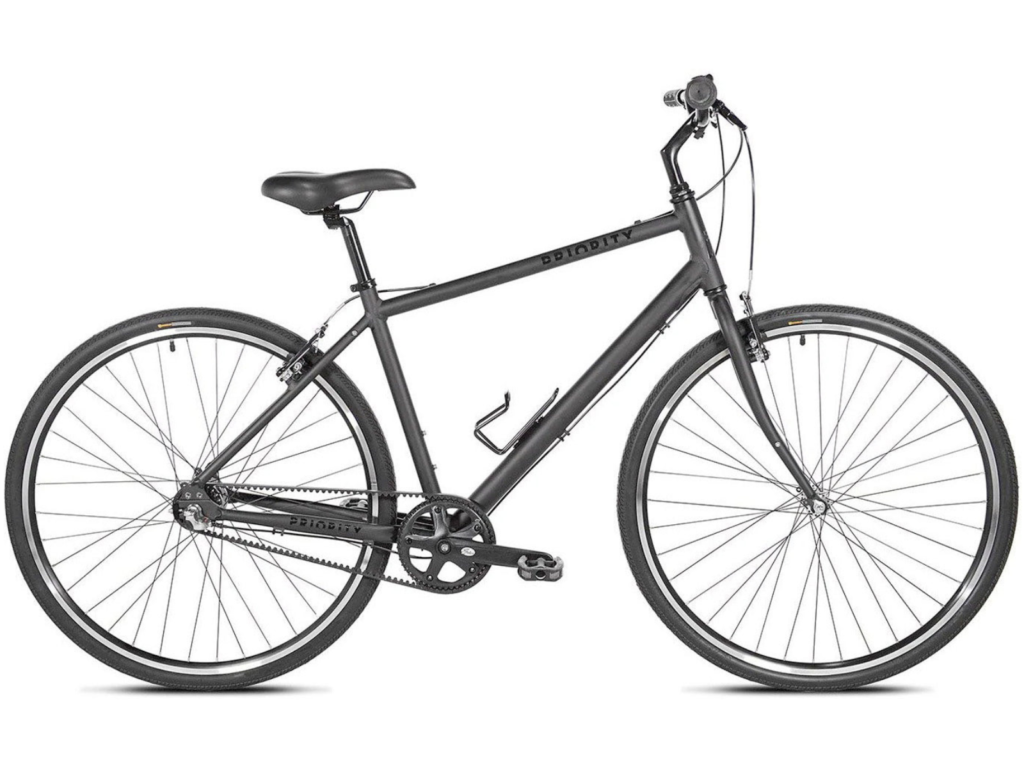Last updated: September 1st, 2023
Hybrid bikes are the champions of versatility, but there’s more variation than you might expect.
Drawing on my personal bikes, test-rides, and extensive research, I’ve rounded up three different but altogether outstanding hybrids at the accessible price point of $600—give or take.
(Due to supply chain turmoil, availability is a bigger factor than in previous years. The previous threshold of $500 no longer buys a bike I’d recommend for daily use.)

The Trek FX 1 and Trek Verve 1 Disc are time-tested, widely available, and a refreshingly good value amid escalating prices.

From bashing curbs to tackling trails, the Norco Indie 4's deep MTB roots are ready to get rowdier than typical hybrid can handle.
Breaking down the best $600 hybrids
As 2023, I believe the Trek FX 1 or Verve 1 Disc, Norco Indie 4, and Priority Classic Plus Gotham Edition are the best readily available hybrids on a limited budget.
The FX is the most generic design of the lot, so it’s the easiest to find alternatives for. The rest are more distinctive, but virtually unbeatable at their price for the right rider.
What about all the good, reputable options not listed here? That’s no knock against them; I’ve just tried to pick ones that stand out in terms of design or availability. I welcome your feedback
The FX 1 is a perennial favorite for good reason: it's a middle-of-the-road design that'll keep commuters, fitness enthusiasts, and leisure riders equally happy. The Verve 1 Disc offers similar value in a more relaxed, upright package.
Key points
The FX and the Verve both have everything a utilitarian cyclist could need: fender mounts, rack eyelets, a good ol’ triple crankset (for wide range on a budget), and city-friendly tire clearance of 35 mm and 45 mm (respectively) with fenders.
Both bikes are neutral in posture: neither hunched forward like a road racer nor bolt-upright as on a Dutch bike. The Verve is the more upright of the two, however, which bumps up comfort but takes a slight hit in efficiency.
In dry weather, the FX 1’s V-brakes may actually outperform the Verve 1’s entry-level Tektro mechanical discs. Good rim brakes are generally more powerful than budget discs. However, the latter are more consistent in wet weather, even if they lack absolute stopping power.
At upwards of 30 lbs, the Verve is heavy even for the entry-level category. Weight hardly matters once you’re rolling, but I’d choose the FX if I needed to haul it up stairs or onto buses’ bike racks.
If these models pique your interest, then check out my deep-dive FX vs. Verve comparison to learn more.
Buy it if…
- You ride on roads and bike paths most of the time, but may venture off the pavement when the urge strikes.
- You like a slightly sporty feel, whether for exercise or for tackling big hills, but shy away from the aggressive lean of a road bike.
- Value and simplicity are paramount, since simply getting out matters most.
All hybrids combine road and MTB influences, but the Norco Indie 4 borrows far more from the mountain side of things. It's far above our limit of $600-ish, but there's no cheaper hybrid that I'd personally choose for rough-and-tumble city riding.
Key points
On chewed-up streets, the Indie 4 feels unperturbable thanks to long, relaxed geometry and remarkably wide 53 mm tires.
Posture-wise, it’s halfway in between the FX and Verve. Modestly swept-back handlebars are a good match, creating a comfortably neutral wrist angle without compromising leverage.
The Indie remains one of the funnest hybrids I’ve ever ridden, but its value is less thrilling. The Tourney derailleur is disappointing at a price where others spec Altus or Acera), and the no-name mechanical disc brakes feel ill-suited to a hard-charging urban bike.
Buy it if…
Even though you ride mostly on asphalt, you embrace (or at least can’t avoid) hitting torn-up streets at speed. A mountain bike would be overkill, and would lack essential rack and fender mounts, but you still need something that’ll take the rough stuff in stride. You only need to climb rolling hills, at most, so a narrow 7-speed range won’t be a problem.
Priority Bicycles is a direct-to-consumer brand that I've had solid experiences with. The Classic Plus Gotham Edition is the most cost-effective way for daily riders to keep maintenance to a bare minimum. It feels and rides similarly to proven hybrids like the Trek FX, albeit with slightly higher (read: more comfortable) handlebars and, most importantly, the most reliable drivetrain possible.
Key points
The grease-free, adjustment-free Gates belt rinses clean and should last 5-10x as long as a chain. Belts aren’t compatible with derailleurs, so Priority spec’d an equally dependable 3-speed internally geared hub from Shimano.
The geometry and feel are similar to mainstream hybrids like the Trek FX and Specialized Sirrus, so it’s highly unlikely to surprise you. That’s for the better, seeing as test rides aren’t generally available.
While I’ve had great experience with this particular Shimano Nexus hub, keep in mind that’s not DIY-friendly. Maintenance is non-existent from day to day, but it’ll need more complex service every few thousand miles. Its 186% gear range is fine for the rolling hills of most cities, but truly hilly places call for wider range.
Finally, well-adjusted V-brakes are more than enough in the dry, and generally preferable to the cheap discs you’ll normally find at this price point. Still, they aren’t as predictable in the rain, and they do require more care than quality discs. I stand by this recommendation for its price. However, daily riders in wet climates may be happier with another model in the Priority line, such as my pick for the year’s all-around best belt-drive bike.
Buy it if…
You like the feel of a mainstream hybrid. Perhaps you’ve even owned (and enjoyed) something like an FX or Sirrus in the past.
However, you’re happy to sacrifice some gear range in exchange for avoiding derailleur cable adjustment, chain care, and annual (at least) chain replacement. Your hills are modest, and you’re not concerned about a strict pedaling cadence, so three speeds will do the trick.
Common questions about budget hybrids
Are cheap hybrids good to commute on?
Yes! Hybrids in general are extremely popular with commuters, especially those who want something livelier than a traditional city bike. The $600 price range won’t buy anything fancy, but it will get you trustworthy name-brand components that are easy to maintain.
What about riding these for exericse?
In general, any bike is good for exercise. Whatever you ride, it’s possible to work equally harder for equally long provided you’re comfortable.
And that’s where hybrids—included these budget models—absolutely shine. They’re just upright enough to relieve neck and wrist strain during long cardio-focused sessions, yet lively enough to be fun (not merely manageable) during sprints.
They seem cool…but why these bikes?
I’ve recommended models that run the gamut, at least as much as possible. Now, understand that $600-ish is on the bottom end of the price range for hybrid bikes that are worth owning. You can certainly spend even less, but then you start sacrificing really important things like hub and headset quality, or wheel construction, that aren’t obvious on paper but can add up to way more maintenance or nuisance down the road.
Some of the very cheapest options are only available through general online retailers, obscure direct-to-consumer brands (results may vary), or big-box stores (like the Target bikes I avoid).
Those aren’t all bad, but buying from a bike shop or a better-known direct-to-consumer brand stacks the deck in your favor in terms of quality and proper assembly.
What else should I budget for?
Depending on how you’re going to ride the bike, there are a couple of absolute must-haves to factor into the price. Check out these essential commuter accessories here.
That’s in addition to whatever clothing and safety equipment you deem appropriate. Besides the relatively sporty Trek FX, all these bikes are relaxed (upright) enough that most people can comfortably ride them in everyday clothes—which bodes well for integrating cycling into daily life.
What’s a good Trek FX alternative?
If you don’t have a Trek dealer nearby, or just have some beef with the brand, then there are countless FX alternatives. The entry-level Giant Escape, Specialized Sirrus, Marin Fairfax, and Jamis Coda (among others) are functionally identical bikes with only trivial differences in specs, geometry, and even price.
After spending time on all the above at some point, I’ve yet to find a difference large enough to declare one a hands-down winner over the rest.

